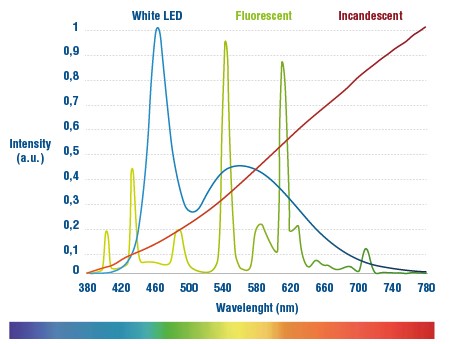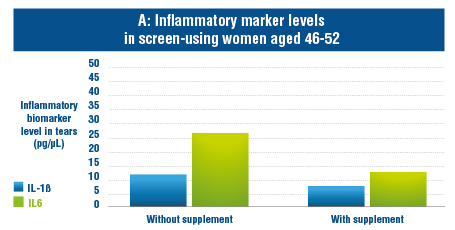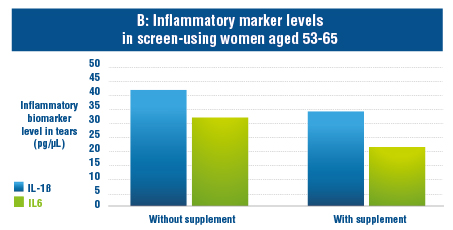THE POSITIVE IMPACT OF DHA ON EYE HEALTH
We have previously discussed the importance of DHA for the developing foetus and children for the development and maintenance of the eye, especially the retina. Supplementation of infant formula with DHA from algae has, for example, been shown to improve visual acuity in formula-fed infants at 12 months of age (1) .
DHA continues to have a key role in eye health in later life and has an even greater relevance as our eyes suffer in our modern environments. In the retina, DHA increases mitochondrial activity and has antioxidative, anti-inflammatory, antiapoptotic (preventing cell death), and antiangiogenic effects. DHA is a major lipid constituent of photoreceptor membranes, where it plays a crucial role in maintaining their structural and functional integrity. Because the continuous renewal of retinal membranes requires a constant supply of omega-3 fatty acids by retinal cells, diets rich in DHA may even improve retinal function, especially where damage has already occurred.
The impact of blue light on our eyes
Over the last 20 years the lighting in our homes has changed remarkably as we move to more energy-efficient bulbs. While the output of incandescent, fluorescent and newer LED bulbs are all seen as white – covering the whole spectrum from blue to red – the character of this light has gradually become more blue. LED lights especially are designed to have a bright light reminiscent of the midday sun and have a large intense peak in the blue area. In addition, our increased reliance on devices with LED-lit screens has further increased our exposure to blue light, often outside of the times where this would have occurred during our evolution.
Figure 1 : Intensities of the various colours that make up ‘white’ light from differement bulb types. From Tosini et al. (2).
The effects of blue light on our circadian rhythms are now recognised, and while there are negative outcomes on our health linked to the disruption of sleep, blue light also has distinct effects on our primary light sensor – the retina.
Numerous studies have identified damaging effects of blue light on the retina which can broadly be classified as either short-term or chronic. Short-term phototoxic effects are linked to acute exposure (less than 12 hours) where the overall levels of light energy cause damage, probably through a mechanism linked to oxidation (2) . Blue light contains more energy than red and so is more damaging. Appropriate amounts of DHA in the cell membranes of the light receptors upregulates the production of the potent antioxidant GSH (3) reducing the potential for damage.
Longer-term effects are linked to chronic exposure over days and months and appear specific to certain wavelengths of light in the blue region.
Evidence from animals suggests that sensitivity to this blue-light damage may be greater during the night than in the day, and while children and young people whose eyes do not fully filter blue light may be particularly sensitive, older eyes are more susceptible to damage. For instance, long-term exposure to blue light leading to oxidative damage is thought to be at least one of the contributing factors to the damage to the most sensitive area of the retina, the macula, in age-related macular degeneration (AMD) alongside low grade inflammation over many years.
Acting against macular degeneration
Age-Related Macular Degeneration (AMD) is the leading cause of irreversible vision loss in the over 65s in the US, and the fourth leading cause of blindness worldwide. It is the result of damage to the macula, the central region of the retina, making it hard to read, recognise faces and carry out many everyday tasks.
DHA is the major structural and metabolic polyunsaturated fatty acid of the retina making up around 20% of its weight, and also has a role in the management of inflammation and so, perhaps unsurprisingly, population studies have shown a correlation between low omega-3 intake and increased risk of AMD (4,5).
Building and maintaining a high level of DHA in circulation appears to provide a level of protection after the first signs of AMD appear (6), and very high dose omega-3 could have some therapeutic benefit in partially restoring vision (7).
Supplements containing DHA Origins™ can help maintain the high levels of circulating DHA that reduce the risk of AMD, and its high concentration of DHA allows a meaningful dose to be combined in a single capsule with other supplements such as the carotenoids lutein and zeaxanthin, or zinc that provide additional protective benefits (8).
Other benefits for the eye
Maintaining high levels of DHA in our bodies may also have beneficial effects on the maintenance of proper intraocular pressure, reducing the risk of glaucoma (9), and can aid in nerve regeneration and wound healing after injury of the eye in animal models (10). It also has a very important role to play at the front of the eye and management of the phenomenon known as dry eye.
Dry Eye
Our modern environment is not kind to the surface of our eyes; pollution, time spent in air-conditioned environments, and spent unblinking in front of computer screens can all impact this delicate organ. The cornea, conjunctiva, eyelids, and tear film are essential for clear vision; losing the tear film can reduce image quality by 20-40% and dry eye is responsible for one in four visits to eye care professionals in the US (11). Dry eye is characterized by ocular surface inflammation and inadequate production of tears, and reducing this inflammation can result in an alleviation of symptom (12). Epidemiological studies in well-nourished western populations have suggested a role for nutritional supplements like omega 3 in delaying the onset or reducing the risk of these disorder.
Intervention studies have been carried out to see if supplementation with omega-3s as an adjunct to treatement with artificial tears could have a beneficial effect, and a recent meta review of these trials has concluded that omega-3 FA supplementation significantly improves dry eye symptoms and signs in patients with dry eye disease (13). Furthermore for a subset of dry-eye sufferers, often women, the disease is immune driven and DHA is particularly important in resolving the condition (14).
The following graphs shows the reduction in inflammatory markers interleukin-b and interleukin 6 in female office workers at risk of dry eye from prolonged computer use. Inflammation is higher in older women but for both groups, consumption of omega 3 and antioxidant supplements significantly reduced this inflammation and corresponded with an improvement in clinical signs and symptoms (15).
Figure 2 : reduction in inflammatory markers in the tears of computer users after supplementation with omega-3 and antioxidants. From Ribelles et al. (15)
The importance of maintaining high circulating DHA for eye health
The eye is a sensitive structure that, due to its interface with the outside world, is particularly susceptible to damage, especially as we age. DHA plays both an important structural role in the eye and a role in resolving inflammation, protecting and reducing the effects of oxidative damage. DHA has a clear preventative role in the long-term health of the eye, with it being important to maintain a high circulating level in our blood; a recent review has supported the use of dietary supplementation with high-dose DHA (around 1g/day) in the form of triglyceride as a potent compound for improving eye health (3).
Other DHA algal oils are limited to 250mg DHA/day when taken as a supplement [1] but DHA Origins™ oil may be taken at doses that provide up to 1g DHA per day, four times the dose of the others, providing an avenue to a solid protective effect.
[1] Doses permitted in Europe under the Union list of Novel Foods
DHA’s role in immunity
As seen above, some of DHA’s beneficial effects on eye health comes through its ability to resolve inflammation. Our next newsletter will examine in more detail how omega-3s, and DHA in particular, can modulate our immune system to positively impact our long-term health.
Bibliography :
- Birch, E. E. et al. The DIAMOND (DHA Intake And Measurement Of Neural Development) Study: a double-masked, randomized controlled clinical trial of the maturation of infant visual acuity as a function of the dietary level of docosahexaenoic acid. Am. J. Clin. Nutr. 91, 848–859 (2010).
- Tosini, G., Ferguson, I. & Tsubota, K. Effects of blue light on the circadian system and eye physiology. Mol. Vis. 22, 61–72 (2016).
- Lafuente, M., Rodríguez González-Herrero, M. E., Romeo Villadóniga, S. & Domingo, J. C. Antioxidant Activity and Neuroprotective Role of Docosahexaenoic Acid (DHA) Supplementation in Eye Diseases That Can Lead to Blindness: A Narrative Review. Antioxidants 10, 386 (2021).
- Wu, J. et al. Dietary Intakes of Eicosapentaenoic Acid and Docosahexaenoic Acid and Risk of Age-Related Macular Degeneration. Ophthalmology 124, 634–643 (2017).
- Merle, B. M. J. et al. Circulating omega-3 Fatty acids and neovascular age-related macular degeneration. Invest. Ophthalmol. Vis. Sci. 55, 2010–2019 (2014).
- Souied, E. H. et al. Oral docosahexaenoic acid in the prevention of exudative age-related macular degeneration: the Nutritional AMD Treatment 2 study. Ophthalmology 120, 1619–1631 (2013).
- Georgiou, T. & Prokopiou, E. The New Era of Omega-3 Fatty Acids Supplementation: Therapeutic Effects on Dry Age-Related Macular Degeneration. J. Stem Cells 10, 205–215 (2015).
- Ho, L. et al. Reducing the genetic risk of age-related macular degeneration with dietary antioxidants, zinc, and ω-3 fatty acids: the Rotterdam study. Arch. Ophthalmol. Chic. Ill 1960 129, 758–766 (2011).
- Saccà, S., Cutolo, C., Ferrari, D., Corazza, P. & Traverso, C. The Eye, Oxidative Damage and Polyunsaturated Fatty Acids. Nutrients 10, 668 (2018).
- Pham, T. L. & Bazan, H. E. P. Docosanoid signaling modulates corneal nerve regeneration: effect on tear secretion, wound healing, and neuropathic pain. J. Lipid Res. 62, (2021).
- Faulkner, W. J. The Role of Omega-3 Essential Fatty Acids in Dry Eye Disease. Int. J. Clin. Exp. Ophthalmol. 1, 55–59 (2017).
- Mohammadpour, M., Mehrabi, S., Hassanpoor, N. & Mirshahi, R. Effects of adjuvant omega-3 fatty acid supplementation on dry eye syndrome following cataract surgery: A randomized clinical trial. J. Curr. Ophthalmol. 29, 33–38 (2017).
- Giannaccare, G. et al. Efficacy of Omega-3 Fatty Acid Supplementation for Treatment of Dry Eye Disease: A Meta-Analysis of Randomized Clinical Trials. Cornea 38, (2019).
- Gao, Y. et al. Dietary DHA amplifies LXA4 circuits in tissues and lymph node PMN and is protective in immune-driven dry eye disease. Mucosal Immunol. 11, 1674–1683 (2018).
- Ribelles, A. et al. Ocular Surface and Tear Film Changes in Older Women Working with Computers. BioMed Res. Int. 2015, 467039 (2015).






